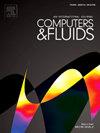Development of a detailed surface chemistry framework in DSMC
IF 2.5
3区 工程技术
Q3 COMPUTER SCIENCE, INTERDISCIPLINARY APPLICATIONS
引用次数: 0
Abstract
A generalized finite-rate surface chemistry framework incorporating a comprehensive list of reaction mechanisms is developed and implemented into the direct simulation Monte Carlo (DSMC) solver SPARTA. The various mechanisms include adsorption, desorption, Langmuir-Hinshelwood, Eley-Rideal, Collision Induced, condensation, sublimation, etc. The approach is to stochastically model the various competing reactions occurring on a set of active sites. Both gas-surface and pure-surface reaction mechanisms are included; and the framework also encompasses catalytic or surface altering mechanisms involving the participation of the bulk-phase species. A general formulation where each surface can have multiple phases and different sites is adopted. Expressions for the microscopic parameters of reaction probabilities and frequencies that are required for DSMC are derived from the surface properties and macroscopic parameters such as rate constants, sticking coefficients, etc. This framework also presents physically consistent procedures to accurately compute the reaction probabilities and frequencies in the case of multiple reactions. The result is a modeling tool with a wide variety of surface reactions characterized via user-specified reaction rate constants, surface properties and input parameters. Finally, the framework implementation is verified for test cases with analytical solutions.
在 DSMC 中开发详细的表面化学框架
一个广义的有限速率表面化学框架,结合反应机制的综合列表被开发和实现到直接模拟蒙特卡罗(DSMC)求解器SPARTA。各种机理包括吸附、解吸、Langmuir-Hinshelwood、eley - ideal、碰撞诱导、冷凝、升华等。该方法是随机模拟在一组活性位点上发生的各种竞争反应。包括气表面和纯表面反应机理;该框架还包括催化或表面改变机制,涉及体相物质的参与。采用一种通用的配方,其中每个表面可以有多个相和不同的位置。DSMC所需的反应概率和频率的微观参数表达式由表面性质和宏观参数如速率常数、粘附系数等导出。该框架还提供了物理上一致的程序,以准确计算多个反应的反应概率和频率。结果是一个建模工具,通过用户指定的反应速率常数、表面性质和输入参数来表征各种表面反应。最后,用分析解决方案验证了测试用例的框架实现。
本文章由计算机程序翻译,如有差异,请以英文原文为准。
求助全文
约1分钟内获得全文
求助全文
来源期刊

Computers & Fluids
物理-计算机:跨学科应用
CiteScore
5.30
自引率
7.10%
发文量
242
审稿时长
10.8 months
期刊介绍:
Computers & Fluids is multidisciplinary. The term ''fluid'' is interpreted in the broadest sense. Hydro- and aerodynamics, high-speed and physical gas dynamics, turbulence and flow stability, multiphase flow, rheology, tribology and fluid-structure interaction are all of interest, provided that computer technique plays a significant role in the associated studies or design methodology.
 求助内容:
求助内容: 应助结果提醒方式:
应助结果提醒方式:


